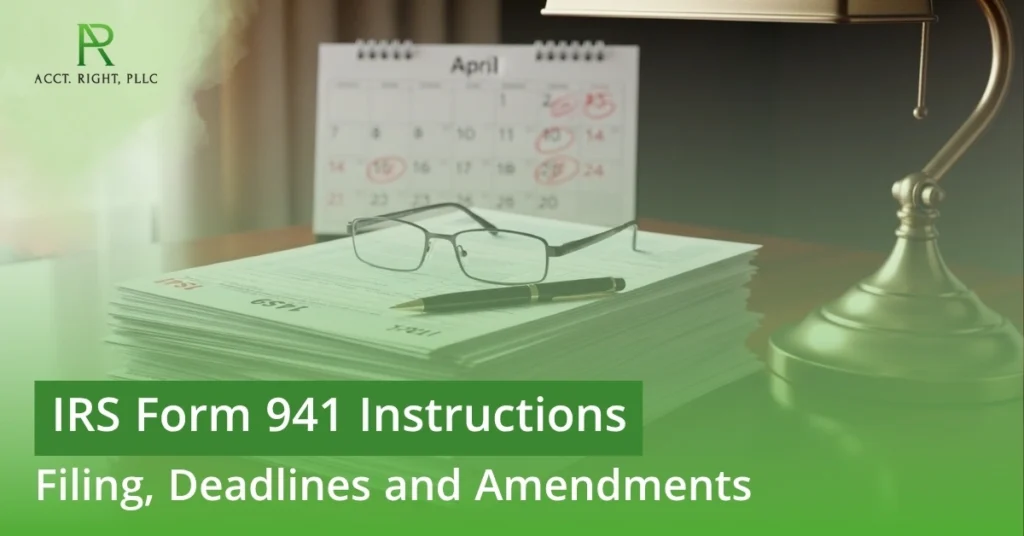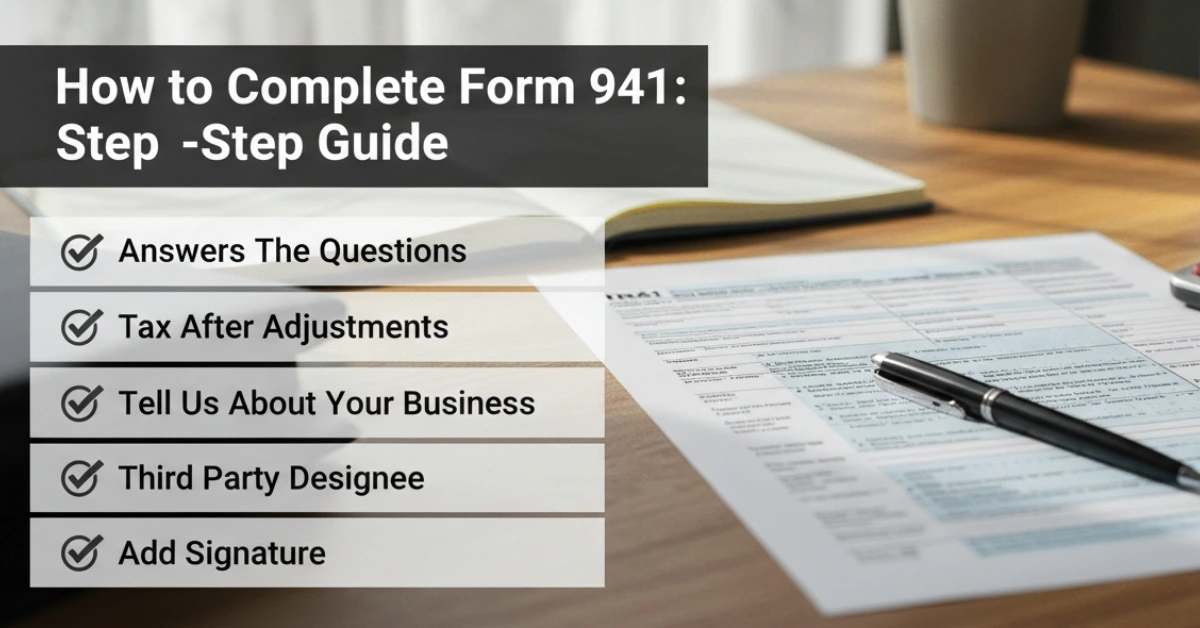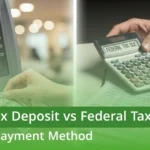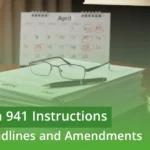
If you’re an employer looking for clear, Form 941 instructions, you’ve come to the right spot. This guide walks you through everything you need to know—from determining who must file, to where to send your form (with or without payment), how to handle corrections using Form 941-X, and understanding the differences between Form 941 and Form 944. We’ll also cover Schedule B and other special scenarios to make filing as straightforward as possible.
We’ll also highlight how our firm, Acct. Right, PLLC can help you stay compliant and stress-free. We specialize in 941 tax instructions and preparation and business accounting services, and we’ll also show how our services can seamlessly support you through this process.
What is IRS Form 941 & Who Uses it?
In simple terms, Form 941 helps the IRS track the taxes your business withholds from employees and ensures you’re paying the correct employer taxes each quarter.
Form 941, the “Employer’s Quarterly Federal Tax Return,” is used by employers to report wages paid to employees and the associated federal payroll taxes, such as income tax withholding, Social Security, and Medicare, quarterly. Filing and deposit obligations are governed by the Internal Revenue Service (IRS), and failure to file on time or pay correctly can result in significant penalties.
If you’re looking to understand how to file your quarterly payroll taxes with Form 941, it’s also important to know about business tax extensions. IRS Form 7004 provides guidance on requesting additional time to file certain business tax returns, which can be helpful if you need extra time for your filings
Who Must File and Who May Use an Alternative
If you pay wages to employees subject to federal income tax withholding, Social Security tax, or Medicare tax, you generally must file Form 941 each quarter.
Exceptions & Alternatives:
- If you received notification from the IRS to file Form 944 (an annual return) instead of Form 941 because your annual employment tax liability is expected to be $1,000 or less.
- If you are a seasonal employer and did not pay wages for a quarter, you may check the “Seasonal Employer” box (line 18) to avoid filing for that quarter.
- If you employ only household workers or farm employees, you may have different forms (e.g., Form 943 for agricultural).
How to Complete Form 941: Step-by-Step Guide
Below is an overview of key sections of Form 941. For full details, refer to the official IRS instructions.
Part 1: Answer These Questions for This Quarter (Lines 1 5)
- Line 1: Number of employees who received wages, tips, or other compensation in the pay period including the 12th of the last month of the quarter.
- Line 2: Wages, tips, and other compensation (that would go in Box 1 of Form W 2).
- Lines 5a 5d: Taxable Social Security wages, Medicare wages and tips, Additional Medicare tax wages. For example, line 5a is wages subject to Social Security tax.
- Line 5e: Total Social Security and Medicare taxes (sum of above).
Part 2 & Related Lines: Tax After Adjustments
- Line 10: Total taxes after adjustments (include things like sick pay, tips).
- Line 11: Qualified small business payroll tax credit for increasing research activities (from Form 8974).
- Line 12: Total taxes due after accounting for any adjustments and nonrefundable credits. This is the key amount used to determine deposit requirements.
Part 3: Tell Us About Your Business (Lines 17 18)
- Line 17: If your business has closed or you stopped paying wages, check this box and enter final date wages were paid.
- Line 18: If you are a seasonal employer (you expect to pay wages only part of the year), check the box. Again, this helps avoid quarterly filings when no wages were paid.
Part 4: Third Party Designee
If you want to allow someone (e.g., your payroll provider or our firm) to discuss the return with the IRS, check “Yes” and provide name, phone number, and PIN.
Part 5: Signature
The form must be signed by an authorized person (owner, partner, principal officer) and include date and phone number. If you use a paid preparer, they must fill in the “Paid Preparer Use Only” section.
Form 941 involves reporting payroll taxes, including Social Security and Medicare withholdings. Understanding IRS rules about Social Security tips can help ensure your Form 941 is filled out accurately and complies with the latest 2025 tax updates.

Filing Instructions for 941: Regular vs Amended vs 944
IRS Form 941 vs Form 944
- Form 944: Employer’s Annual Federal Tax Return is for very small employers (tax liability $1,000 or less for the year) who are notified by the IRS to file annually instead of quarterly.
- If you’re eligible and notified for Form 944, you do not file Form 941. Otherwise, you must file a 941 quarterly.
Form 941 X: Amended Return
If you find an error on a previously filed Form 941 for example wages were understated or Social Security tax withheld was wrong, you must file the Form 941 X, Adjusted Employer’s Quarterly Federal Tax Return or Claim for Refund.
Key points for 941 X:
- Use the correct revision.
- You can now e-file 941 X via Modernized e-File (MeF).
- Do not attach the original 941 to the 941 X unless specifically required. (Payroll practitioners often ask this, per community discussion).
941 Schedule B Instructions (Form 941)
This schedule is required if you are a semi-weekly depositor (i.e., your employment tax liability exceeded $50,000 in the look-back period) or if you’re subject to next-day deposit rules.
Where do “Types of 941” come in?
By “types” of 941, we may refer to:
- Regular quarterly 941
- Amended 941 via 941 x
- 941 with Schedule B (semiweekly depositors)
Where to Mail Form 941 (With vs. Without Payment)
E-Filing Recommended:
The IRS encourages filing Form 941 electronically through the Modernized e-File (MeF) system. If you e-file, no paper return is needed.
Paper Filing:
-
With Payment: If you owe taxes (line 14 shows a balance due) and are sending a check or money order, mail to the address in the “With Payment” section of the IRS instructions.
-
Without Payment: If no tax is due (line 14 must be zero) or you have already paid electronically, mail to the “Without Payment” address for your state.
Electronic Payments:
All federal tax deposits should be made via EFTPS, IRS Direct Pay, or bank wire, unless your liability is under $2,500 and the prior quarter was also under $2,500. If you pay by check instead, attach Form 941-V (Payment Voucher).
Deadlines:
- Q1 (Jan–Mar) → Apr 30
- Q2 (Apr–Jun) → Jul 31
- Q3 (Jul–Sep) → Oct 31
- Q4 (Oct–Dec) → Jan 31 (next year)
If the due date falls on a weekend or holiday, file the next business day.
Tip: For paper filings, use certified mail or a tracked delivery to ensure proof of filing.
Common Mistakes, Penalties & How to Avoid Them
Common Errors:
- Using an outdated Form 941.
- Missing or mismatched EIN, name, or address.
- Leaving Part 1 lines blank or rounding incorrectly.
- Failing to deposit taxes on time, even if the form is filed.
- Filing Form 941 instead of Form 944 (or vice versa) when eligible.
How to Avoid Issues:
- Deposit taxes on time, not just file the form.
- Use the correct quarter box and attach schedules like Schedule B.
- Review the annual “What’s New” section in IRS instructions.
- Consider professional help, like Acct. Right, PLLC, to review filings and ensure compliance.
Conclusion:
Filing Form 941 correctly, quarter after quarter, is a vital part of your business’s tax compliance. With the 2025 revision of the instructions now in effect, staying current with rates, deposit schedules, and form revisions is more important than ever. At Acct. Right, PLLC we bring the expertise, industry-specific knowledge, and tailored service to help you navigate these requirements accurately and with confidence.
If you’re ready to outsource your Form 941 preparation, or you need help reviewing your deposit schedule, correcting previous filings, or planning your tax posture for the upcoming quarter, contact us today. Let us handle the compliance so you can focus on growing your business.
Disclaimer:
This content is intended to provide general information and should not be considered professional tax or legal advice. We offer personalized tax and accounting services tailored to your unique business needs. Some images in this blog are AI-generated and meant for illustration purposes only.
Frequently Asked Questions
What if my business made no payroll this quarter?
If you’re a regular employer (not seasonal), you still must file Form 941 and enter zeros. If you are seasonal and anticipate no wages, you may check line 18 and skip filing for that quarter.
How do I know if I should use Form 944 instead?
If your annual employment taxes are $1,000 or less and the IRS has notified you to file Form 944, then you can. Otherwise, you must file Form 941 quarterly.
What deposit schedule applies (monthly vs semiweekly)?
If your look-back period employment taxes exceed $50,000, you’re likely on a semiweekly deposit schedule and may need Schedule B.
What if I use EFTPS for deposits but forget to file the form?
Depositing tax payments and filing Form 941 are separate obligations. Deposits don’t substitute for filing.
What are the penalties for late filing?
Failure to file or pay on time may result in penalties such as 5% of the unpaid tax for each month late (up to 25%) plus interest.




